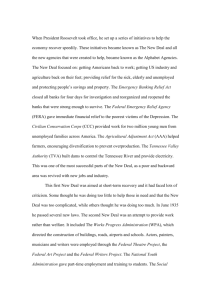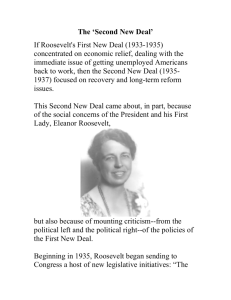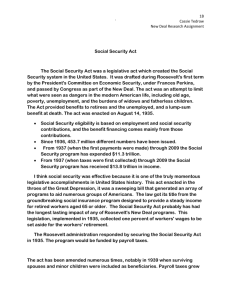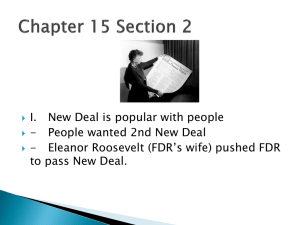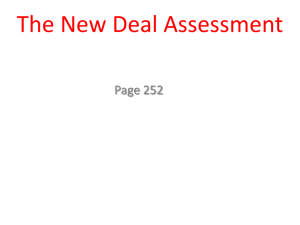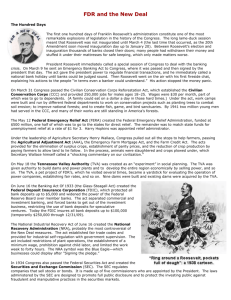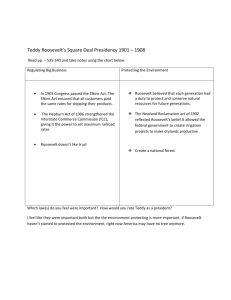Chapter 10 Lecture
advertisement
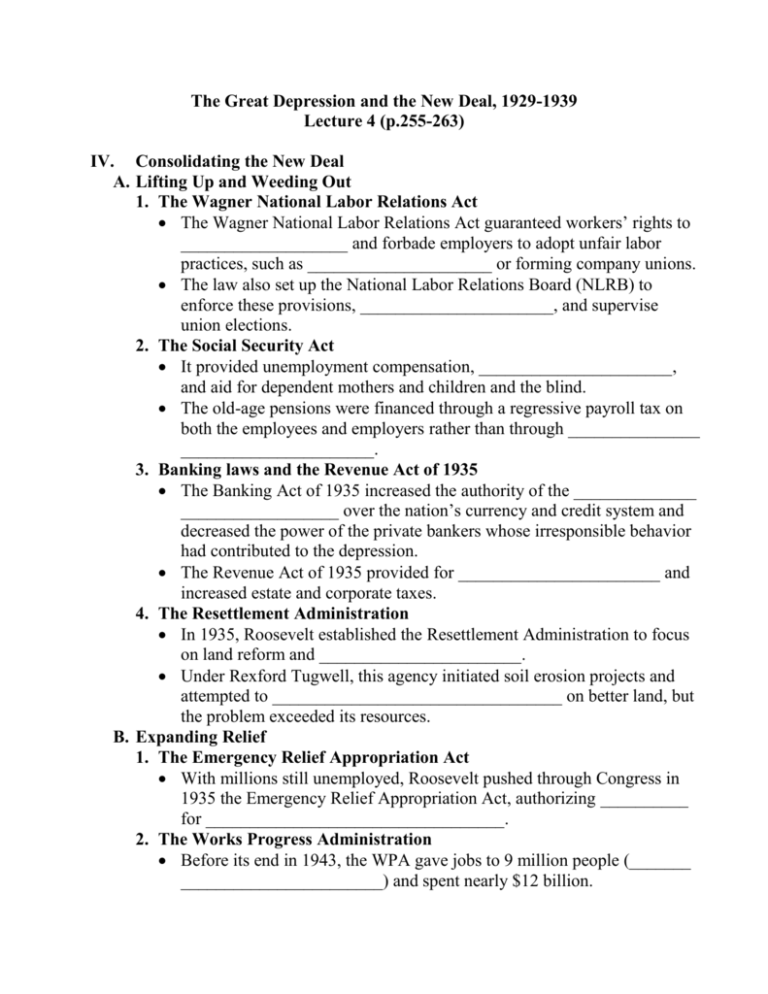
The Great Depression and the New Deal, 1929-1939 Lecture 4 (p.255-263) IV. Consolidating the New Deal A. Lifting Up and Weeding Out 1. The Wagner National Labor Relations Act The Wagner National Labor Relations Act guaranteed workers’ rights to ___________________ and forbade employers to adopt unfair labor practices, such as _____________________ or forming company unions. The law also set up the National Labor Relations Board (NLRB) to enforce these provisions, ______________________, and supervise union elections. 2. The Social Security Act It provided unemployment compensation, ______________________, and aid for dependent mothers and children and the blind. The old-age pensions were financed through a regressive payroll tax on both the employees and employers rather than through _______________ ______________________. 3. Banking laws and the Revenue Act of 1935 The Banking Act of 1935 increased the authority of the ______________ __________________ over the nation’s currency and credit system and decreased the power of the private bankers whose irresponsible behavior had contributed to the depression. The Revenue Act of 1935 provided for _______________________ and increased estate and corporate taxes. 4. The Resettlement Administration In 1935, Roosevelt established the Resettlement Administration to focus on land reform and _______________________. Under Rexford Tugwell, this agency initiated soil erosion projects and attempted to _________________________________ on better land, but the problem exceeded its resources. B. Expanding Relief 1. The Emergency Relief Appropriation Act With millions still unemployed, Roosevelt pushed through Congress in 1935 the Emergency Relief Appropriation Act, authorizing __________ for __________________________________. 2. The Works Progress Administration Before its end in 1943, the WPA gave jobs to 9 million people (_______ _______________________) and spent nearly $12 billion. Three-fourths of its expenditures went on ____________________ that could employ manual labor: the WPA built 125,000 schools, post offices, and hospitals; 8,000 parks; nearly ____________________; and enough roads and sewer systems to circle the earth _______________________. The WPA also developed work projects for unemployed ____________, ________________, _____________ and _____________. The National Youth Administration (NYA), another WPA agency, gave part-time jobs to students, enabling 2 million high school and college students to ___________________, learn skills, and do productive work. C. The Roosevelt Coalition and the Election of 1936 Conservatives were alarmed at the ____________________, businesspeople angered by regulation and labor legislation, and well-to-do Americans furious with ______________ decried the New Deal. The New Deal’s agricultural programs reinforced the traditional Democratic allegiance of _______________ while attracting many _________________. Labor legislation clinched the active support of the nation’s _____________. Middle-class voters, whose ________________________ and whose _____ ________________________, also joined in the Roosevelt coalition. Also part of the coalition, were urban ethnic groups, who had benefitted from ___________________ and received unprecedented ______________. The political realignment produced a landslide. Roosevelt polled _________ of the popular vote and the largest electoral vote margin ever recorded, 523 to 8. V. The New Deal and American Life A. Labor on the March 1. The Congress of Industrial Organizations Formed within the AFL, the Committee for Industrial Organization (CIO) campaigned to unionize workers in the _________, ________, and _________ industries, all notoriously hostile to unions. AFL leaders insisted that the CIO disband and then in 1937 __________ __________. The militants reorganized as the separate Congress of Industrial Organizations. 2. The sit-down strike The CIO also employed new and aggressive tactics, particularly the sitdown strike, in which workers, rather than picketing outside the factory, simply _________________________, thereby blocking both production and the _______________________________. Sit-down strikes paralyzed General Motors in 1937 after it refused to recognize the _____________________________. 3. The Memorial Day Massacre In Chicago in 1937, police guarding a plant of the Republic Steel Company fired on the strikers and their families, __________________ as they tried to flee. Scores more were wounded and beaten. New Deal labor legislation, government investigations and court orders, and the federal refusal to use force against the strikes helped the labor movement __________________________ for American workers. B. Women and the New Deal Women on relief were restricted to “women’s work” – more than half worked on _____________________, regardless of their skills – and were paid scarcely _______________________________. Although women constituted nearly a fourth of the labor force, they obtained _______________________ created by the WPA, 12 percent by FERA, and 7 percent by the CWA. The CCC _____________________ altogether. By ________________________________, the NRA brought relatively greater improvements to women, who were concentrated in the lowest-paid occupations, than to male workers. Women also ________________________________ under the New Deal. Appointed to positions in the Roosevelt administration, they helped _______ ______________________ New Deal social legislation. Eleanor Roosevelt roared across the social and political landscape of the 1930s, _____________________________, demanding reforms, traveling across the country, writing newspaper columns and speaking over the radio, developing plans to help unemployed miners and abolish slums. C. Minorities and the New Deal 1. The New Deal and African Americans a. New Deal discrimination against African Americans The CCC ____________________; NRA codes often specified _____ ___________ and benefits for black workers relative to white workers or even ___________________________ from jobs. b. Benefits for African Americans in New Deal programs Roosevelt appointed black people to important positions, including the first black federal judge. Under the New Deal, ____________________________ because of federal education projects, and the number of black college students and graduates more than _________________, in part because the NYA provided student aid to black colleges. New Deal relief and public health programs reduced ______________ ______________________ and raised life expectancy rates. 2. The New Deal and Native Americans More than _______________ Indians received training in ___________, __________, and animal husbandry, along with basic academic subjects. The Indian Reorganization Act of 1934 guaranteed religious freedom, reestablished tribal self-government, and halted the sale of tribal lands. 3. The New Deal and Hispanic Americans Hispanic Americans received less assistance from the New Deal. Farm workers remained largely ______________, _______________, and at the mercy of agribusiness. D. The New Deal: North, South, East and West The New Deal’s agricultural program boosted farm ___________________ in the __________ more than any other region. The resulting modernization helped replace an archaic sharecropping system with an emergent agribusiness. The New Deal also improved Southern cities. FERA and WPA built urban _______________, airports, bridges, roads and harbor facilities. The federal government had a particularly powerful impact on the South with the Tennessee Valley Authority (TVA), launched in 1933. Coordinating activities across seven states, the TVA built dams to ___________________ and __________________________, produced fertilizer, fostered agricultural and forestry development, encouraged conservation, improved navigation, and modernized school and health systems. The New Deal further expanded access to electricity by establishing the Rural Electrification Administration (REA) in 1935. By 1950, ___________ of American farms had electricity. Westerners received the ______________________ per capita in welfare, relief projects, and loans. The Bureau of Reclamation, established in 1902, built _______________to control the Western river systems, promote large-scale development, prevent flooding, _____________________________, and created reservoirs and canal systems to bring water to farms and cities. E. The New Deal and Public Activism Despite Hoover’s fear that government responsibility would discourage local initiative, New Deal programs, in fact, often _________________________ groups to _________________________ and social and economic behavior. Because the administration worried about centralization, some federal agencies fostered what New Dealers called “________________________.” At times, federal programs allowed previously unrepresented groups to ______________________________________.
